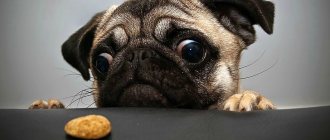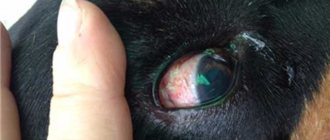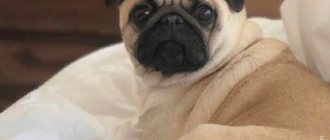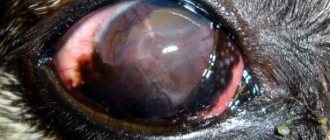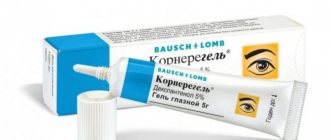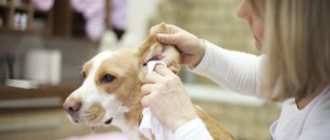Due to the structure of the skull and the shape of the eyelid, pugs often suffer from eye diseases. Tears, redness, and swelling are alarming and make you frantically look for ways to help your pet before visiting the veterinary clinic.
What eye diseases exist in dogs of this breed? What should you buy in your home medicine cabinet? When is it better not to delay visiting a doctor? Read our article!
Home care
You should start monitoring the condition of your pug's eyes 10 days after his birth. It is then that his eyes begin to open, and are visible from under the raised eyelid from the inner corner. The immunity of ten-day-old puppies is not yet strong enough, and if a nursing mother has conjunctivitis, it is likely to be passed on to the offspring.
Important! If your female pug has eye problems, treat them before treating her with a cable. This way you will prevent the possible development of diseases in future offspring.
You can keep your pug's eyes healthy by regularly following these rules:
- Check the corners of your eyes for dirt every day, especially after walking, and wipe them with a damp cloth.
- Monitor the state of lacrimation. If your eyes begin to water intensely or, conversely, become dry, this is a reason to consult a doctor.
- Make sure that while walking, litter, dust and sand do not get into the pug’s eyes.
- Make sure that the pug is not exposed to the wind or draft for a long time.
- Make sure your veterinary medicine cabinet is full so that you always have the necessary medications at hand.
What to wash and drip with?
If you are the owner of a pug, make sure that your veterinary medicine cabinet always contains the following medications:
- physical solution;
- chloramphenicol;
- tetracycline ointment;
- antiallergic drugs (tavegil, suprastin);
- tsiprovet.
Almost all of the above pharmaceuticals can be purchased at a regular “human” pharmacy. Having them at hand, you can be sure that, if necessary, you will be able to provide first aid to your pet and alleviate its condition before a medical examination.
How to wipe?
The pug's eyes are round and quite large. Due to their specific shape and the dog’s small stature, debris and dust regularly settle in them. You need to wipe your pug's eyes at the same time every day. This way you will accustom the dog to the necessary “ritual” of cleanliness, and he will not experience stress and resist.
Remove accumulated mucus with a cotton pad soaked in boiled water or saline solution, moving in the direction from the outer corner to the tear duct.
Important! Normally, a pug's eyes are slightly moist. Tears should not flow from them, nor should they be excessively dry and faded.
Caring for pug eyes when sick
Let's look at the features of caring for pugs at home.
Wool and bathing
Pugs only need to be brushed once a week. This should be done in the direction of hair growth. A furminator is best suited for this. But you can use a rubber comb or a glove. During the shedding period, daily brushing is required.
We invite you to read: Lactobifadol for cats - buy in Moscow in the Gomeovet store, price of the probiotic Lactobifadol for cats
Pugs do not need to be washed frequently. Do this whenever it gets dirty or smells bad. Otherwise, you risk washing off the protective layer from your skin.
Dogs take baths well. To make your pet feel more confident and keep his paws from moving apart in the bath, lay down a rubber mat. To prevent water from getting into your ears, place cotton swabs in them.
The wool can be dried naturally or using a hairdryer. Make sure that the air flow is not strong and hot.
Within a few days, the fur from the pugs will fall off with a vengeance. It is recommended to comb it immediately after bathing.
Pugs have special eyes - they are large, expressive and poorly protected from dust and injury. They require careful care.
Every morning, inspect and cleanse with a cotton pad soaked in a special lotion. Do not treat your eyes with tea leaves, boric acid or manganese acid. And also albucid - it causes a burn.
Pugs' eyes water moderately, thereby washing away any trapped debris. If the discharge is heavy, contact your veterinarian.
During the teething period, regularly inspect your puppy's mouth. Molars can begin to grow when baby teeth have not yet fallen out. In order not to spoil the bite, the doctor removes the baby teeth in such cases.
Pugs' lips fit tightly to their jaws, making them difficult to clean. Try to do everything to prevent tartar from appearing. To do this, dogs are given cartilage and special bones to chew on. Eating dry food can prevent plaque formation. You can use an anti-tartar spray.
Pugs' ears are one of its weak points. The breed standard allows two types:
- Rosettes - the ears are located on slightly broken cartilage. The ear canal remains slightly open.
- Button ears are completely floppy ears. Gives the head additional volume. Preferred option.
At 3 months, the dog begins to break down its cartilage. Only then can you understand what shape the ears will take. Some owners who do not plan to participate in exhibitions leave the rose ears.
But the “button” shape is preferable not only for its attractiveness. A bare ear canal is more susceptible to dirt and infection.
There is a way to influence the process of ear formation. To do this, they are sealed with adhesive tape, giving the desired shape. The process is completed only by 1.5-2 years. You need to be patient.
Pugs' sulfur is dark brown in color. You can remove it with a dry cotton swab or disk. Or you can use a special oil-based lotion.
If a pug's ear turns red, the amount of wax increases and discharge appears, this may mean the beginning of an inflammatory process. Do not treat it yourself, contact your veterinarian.
Overgrown claws cause discomfort to the dog. They interfere with walking, as a result of which the dog places its paw incorrectly. This can lead to limb deformities.
Trim the nails as they grow. Do this with wire cutters or a nail clipper. Do not touch the pulp located inside the nail plate. This will cause the dog pain and bleeding.
The skin on a pug's nose is quite dry and may crack. Lubricate it with oil.
Dust, dirt, and sweat accumulate in the folds. They cause an unpleasant odor and irritation. 1-2 times a week, clean the folds with special wipes or a cotton pad soaked in hydrogen peroxide.
Puppy care
Before bringing your puppy into the house, remove all small objects from their reach. He can swallow them. Try to protect sharp corners and furniture handles at the height of the pug.
Learn for yourself and show your children how to properly pick up a puppy. One hand should be under the chest, and the other under the seat.
You cannot pull your pet by the paws, squeeze its stomach, or take it by the scruff of the neck.
From the very beginning, you need to start raising a pug. Don't indulge his whims, but don't punish him just like that.
Teach your pet to bathing and trimming its nails. Be patient until he learns to use the litter box.
A few more tips:
- remove all visible wires - the puppy may chew them;
- Do not leave your little pug alone on the sofa or chair. He may fall and hurt his paws;
- Until your pet has received all its vaccinations, remove outdoor shoes. It is on it that we bring home diseases that are dangerous to animals;
- Do not forcefully pull objects out of your puppy's mouth. You may damage your jaw.
Pug puppies are born blind, but by 9-11 days they begin to open them from the inner corner. From this moment it is necessary to begin to closely monitor the condition of the pug's eyes. Staphylococcus, which can be carried by adults, is dangerous at this stage; it can cause purulent conjunctivitis in puppies.
Daily eye care for your pug should include:
- mandatory checking of the corners of the eyes and cleaning with a damp but well-wrung out soft cloth to remove any accumulation of secretions;
- control over the intensity of tear production and the general condition of the eyes;
- supervision during walks to avoid mechanical damage;
- avoiding drafts and exposure to strong air flow (wind, etc.);
- availability of necessary medications and materials in the first aid kit.
We suggest you read: If your pug's eyes fall out
In the event of mechanical damage to your pug's eyes or infection, you must seek help from a specialist as soon as possible and strictly follow the care recommendations given by him. But you also need to be “fully prepared” at any moment and be able to help your pet if it is impossible to contact a veterinarian.
Eye injury
It happens that after a walk through an area with tall grass or after a run-in with a cat or other animal, as well as after interacting with other dangerous objects, a white spot or cloudiness will appear on the pug’s eye, the pet will begin to squint its eye - it is possible that the dog has suffered an eye injury and You must immediately consult a doctor.
In exceptional cases, if it is impossible to contact a specialist, it is possible to use, according to the instructions, drops (ointments, gels) containing an antibiotic (chloramphenicol, Tsiprovet, Tobrex, Floxal), antiviral and healing (Solcoseryl, Korneregel).
For minor damage to the cornea of the eye, use chloramphenicol eye drops, 10% glucose in ampoules and vitamin eye drops - these measures will prevent the appearance of a cataract. However, if the thorn has already appeared as a result of a minor injury, the same drugs are also used 5-6 times a day with an interval of 10-15 minutes between them.
You should also keep in mind that hormonal drugs should not be used for eye injuries. To prevent your pet from constantly touching his eyes, you can wear a funnel collar around his neck.
Eye infections
If a morning check of your pug's eyes reveals the presence of greenish-yellow mucus, there may be an infection in the eye and medical attention is required. First, you need to use a soft, clean cloth, soaked in saline and wrung out well, to remove mucus and crusts from the eyes, then drip chloramphenicol eye drops, and after 10-15 minutes, apply tetracycline ointment for the eyes.
The presence of crusts on the eyelids and sticking of the eye(s) are signs of conjunctivitis. In this case, it is also necessary to clean the eyes of mucus and crusts with a cloth soaked in saline (use different swabs for each eye so as not to transfer the infection to the other eye). Chlorhexidine digluconate can also be used for rinsing.
Then you can apply tetracycline eye ointment, repeat the procedure 3-4 times a day for 3-4 days. If there is no improvement or worsening of the animal’s condition, consultation with a specialist is mandatory. It is important to remember that albucid should not be used, as it can cause a burn to the eye mucosa.
Swelling of the eye
An injury to the eye may be indicated by its swelling or puffiness, help can be the same, however, if the pet does not allow its injury to be addressed, it is necessary to urgently contact a specialist, since the injury may be very serious, or even be the result of a foreign body, in this case the use of, for example, healing drugs is contraindicated, and, in general, self-medication is undesirable.
Swollen tissue around the eyes may also indicate an allergic reaction or an insect bite. In this case, it is necessary to use antihistamines (suprastin - tablets or injections, lamilan), and in case of a bee or wasp sting, the sting must also be removed.
Discharge from the eyes
Like any other mammal, a pug's eyes need constant hydration. Along with the discharge from the eyes, the remaining dust and dirt that got there during a walk or from the floor are removed, and since pugs are very curious, such curiosity brings a lot of problems with the eyes.
Abundant transparent discharge without signs of turbidity may indicate an allergic reaction, but discharge of a yellowish-green color is a sign of infection of the eye, while a brown (reddish) tint indicates poor nutrition. Self-medication in this case is extremely dangerous, an ophthalmologist will help.
Eye loss
In case of a serious blow to the head, pugs may experience a prolapse of the eyeball, and although this sight is not for the faint of heart, the pet must be given first aid: moisten a clean gauze cloth or other clean material generously with saline solution and place it on the eye, secure with a bandage.
- Antiseptics for care: Miramistin, solution of potassium permanganate, baby lotions for diaper rash;
- For diaper rash and excessive moisture: Tsamaks powder;
- To relieve redness: D-panthenol ointment, Tic-Tac children's skin cream;
- Antibiotics: Levomekol;
- For acne: brilliant green;
- In case of severe inflammation: Doctor dog shampoo;
- Against fungus: Clotrimozole and Yam ointments;
- For brown crust: any fatty cream, for example Vaseline oil. Forum users claim that dry crust is an allergy, and it is quite easy to eliminate crusts at home.
We suggest you read: Maintenance and care of the aquarium fish zebrafish
Red squirrels
There may be three reasons why a pug’s eyes may be red:
Conjunctivitis
An inflammatory process caused by pathogenic bacteria or viruses entering the mucous membrane. With bacterial conjunctivitis, the eye becomes red and purulent discharge appears; with viral conjunctivitis, slight clear mucus appears.
Bacterial damage to the organs of vision should be treated with antibacterial drops and ointments. Perfect for this purpose:
- Tsiprolet;
- Phloxal;
- Levomycetin (drops);
- Tetracycline (ointment).
In case of a viral infection, it is enough to rinse the eyes with saline. solution until improvement occurs. If after 5 days of intensive treatment there is no improvement, be sure to visit a veterinarian.
Keratitis
With keratitis, redness of the eyes is accompanied by attacks of photophobia. The dog constantly closes its eyes in the light, and sometimes cannot open its eyelids at all.
Reference! In pugs, keratitis develops due to the growth of the nasal fold. Increasing in size, it begins to touch and damage the cornea of the eye.
In the early stages, the disease can be treated with medication under the supervision of a doctor. As it progresses, keratitis can lead to loss of vision or the vital need for surgical removal of the eye.
Entropy
Entropy is a disease caused by the appearance of an extra fold on the eyelid (most often the upper one). The eyelashes curl inward and put pressure on the eyeball. The disease can be detected only at six months of age and later. In particularly difficult cases, the problem is solved by surgical shortening of the eyelid.
Tears
Here are some reasons why your pug may be crying and blinking non-stop:
- Keratoconjunctivitis. Inflammation and increased lacrimation are caused by insufficient secretion of eye mucus and drying out of the apples. Treatment is selected by a veterinarian on an individual basis.
- Bringing debris into the eye - during a walk, sand or debris could get into the dog's eye, which causes irritation and tears. Carefully inspect your pet's eyes and if you find debris, thoroughly rinse the eye with physical water. solution.
Treatment of skin folds
Multiple folds on the pug's face require careful care, especially in the warm season.
After eating and walking, bacteria accumulate in them, which can cause an unpleasant odor and the development of fungal diseases or infections.
In addition, they can rot, causing the dog to develop irritation and dermatitis.
It is necessary to wipe the pug's folds twice a week with a cotton swab dipped in a special lotion that does not contain alcohol. First of all, you should wipe the area under the eyes, and then all the folds on the face. After the procedure, the skin under the nose should be lubricated with olive oil or Vaseline. In the cold season, this procedure can be reduced to 1 time per week.
Fester
Suppuration and sticky yellow-green crusts on the eyes are a sign of conjunctivitis that has developed as a result of a staphylococcal or streptococcal infection.
In the initial stages, you can get rid of the disease yourself by washing with saline solution and instilling antibiotic eye drops (Levomycetin or Floxal). In the absence of drops, you can use tetracycline ointment.
The procedure must be repeated three times a day. If there is no improvement on day 5, contact your veterinarian. He will select more effective treatment methods for your pet.
Ears, teeth and claws
Pug ears require special attention and care due to the breed's tendency to get ear infections. To maintain cleanliness and prevent disease, ears must be cleaned as they become dirty - approximately once every 2 weeks, using:
- boric alcohol;
- 3% hydrogen peroxide;
- a special lotion that can be purchased at any pet store.
Having chosen a product, you need to moisten a cotton pad in it, squeeze it out and carefully clean the folds of the ear so that there is no hair, dust or dirt left on them. You should also place a couple of drops in the pug’s ears, massage them for half a minute, and then use a cotton swab to clean the inside of the ear.
An unpleasant odor coming from a dog's ears is a symptom of otitis media or infection. And black dirt and itching may indicate ear mites.
Dental health is a very important point in a dog’s life. Therefore, brushing your teeth is one of the mandatory hygiene procedures.
To remove plaque from a young dog’s teeth, you can contact a veterinarian who will perform the procedure under anesthesia.
However, this method is unacceptable for dogs over 7 years old, since their hearts are unlikely to tolerate anesthesia. To clean the teeth of dogs of any age, use a special toothpaste and brush.
At home, you can use a terry cloth soaked in a solution of baking soda. You should fix the pet's head, carefully lift the upper lip and begin cleaning. In addition, you need to give your dog special treats sold in pet stores and pharmacies.
To care for claws, you need a special nail clipper, with which, in order to avoid creases and delamination, you should trim the dog’s nails as they grow - about twice a month. The procedure must be carried out carefully so as not to touch living tissue. Otherwise, cutting the nail short will cause pain to the dog and may cause bleeding. Claws that are trimmed at the wrong time will interfere with the pug's movements and can lead to deformed toes.
Why did the spots appear?
If your pug has strange spots on its eyes, you should not hesitate to visit a doctor. The cause of the disease in most cases is pigmentous keratitis. Pugs are susceptible to this disease for a variety of reasons:
- turning of the eyelids;
- trichiasis;
- districhiasis;
- dry eye syndrome;
- lagophthalmos.
Pigmentous keratitis requires intensive treatment under medical supervision. If the disease is left to chance, the dog may go blind or lose an eyeball.
Cloudy film and eyesore
A cloudy eye, as if covered with a whitish film, in most cases is a consequence of injury. Only a veterinarian can accurately determine the cause and extent of the damage, as well as select the appropriate treatment. In most cases, treatment with antiviral, wound-healing or antibacterial drops is prescribed.
If the consequences of the injury are not treated in a timely manner, an incurable thorn will form on the eye, which will affect the pet’s visual acuity.
What to do if you are injured?
In pugs, like other brachycephalics, the eyes are injured very often. If you notice that the eye is red, watery and swollen, consult the contents of your veterinary medicine cabinet. Levomycetin or tetracycline ointment will help relieve signs of inflammation, and eye drops will reduce tearing on the damaged cornea.
Reference! In some cases, large debris may get into the eye, which, sinking into the folds of the eyelid or tear ducts, causes severe discomfort to the pet. It can only be obtained using a special medical instrument in the veterinarian’s office.
What should be in a dog's eye first aid kit?
This list is advisory in nature and you should remember that self-medication can harm the dog.
Sodium Chloride solution 0.9% (Physiological solution)The solution is used for preventive cleaning, as well as for washing the eyes. It is considered the most gentle solution, because... its composition is similar to that of tear fluid. The cost of the drug ranges from 30 to 50 rubles, depending on the volume of the bottle. |
Chamomile flowersFor convenience, it is better to purchase it in the form of filter bags. Brew 1 sachet in a glass of hot water. After 15 minutes, the prepared solution (after cooling) can be used to wipe or wash the eyes for redness, purulent discharge, itching, and minor swelling. 1 box costs about 60 rubles. |
Eye drops “Diamond eyes”Sold in veterinary pharmacies and pet stores. Special eye drops for animals that relieve swelling and have an anti-inflammatory effect. In some cases, drops can be applied to a cotton swab and treated with eyes. The average cost of the drug is 140 rubles. |
Tetracycline eye ointmentAn ointment containing an antibiotic. Used for purulent and excessive mucous discharge from the eyes. 0.5-1 cm of ointment is applied to the lower eyelid 2-3 times a day (after removing crusts and discharge). A tube costs about 50 rubles. |
Bulging
Pugs have a rather specific skull structure due to which their eyes are essentially protected only by their eyelids. Severe stress, old age, weakened immunity can lead to eyeball loss.
It is quite difficult to confuse this phenomenon with something else. The pet looks scary - its eyeball looks huge and protrudes from its socket. It is covered with small vessels and is very watery.
The owner’s main task in this situation is to calm down and do everything possible to preserve the health of the animal. Act clearly and quickly, following the following instructions:
- Rinse the eye generously with saline. solution.
- Secure a sterile napkin on it with a bandage.
- Take your dog to a veterinarian immediately or call a doctor at home.
The specialist will set the eye back in place and tell you what care the animal will need in the future.
Nutrition
Pugs are prone to obesity, allergies, and digestive problems. You need to monitor their diet from a very early age.
Puppies are fed 4-5 times a day in small portions. At 6 months, the amount of food intake is reduced to 3 times. After 8 months they are switched to two meals a day.
Nutrition should be balanced. The menu includes:
- lean meat (2/3 of the entire diet) - beef, rabbit, chicken;
- boiled sea fish, without bones - haddock, cod, halibut;
- offal – heart, liver, tripe, stomach;
- cereals – buckwheat, rice, rolled oats;
- vegetables (do not overuse potatoes);
- fruits and dried fruits;
- greens - parsley, dill, spinach, celery;
- fermented milk products – kefir, fermented baked milk, cottage cheese;
- vegetable oil – unrefined sunflower, olive.
The break between feedings is 12 hours. Give your dog something to eat after a walk. Try to do this at the same time. Food should be freshly prepared, warm (not cold or hot). Due to the structure of their jaw, Pugs are unable to consume liquid food.
Prohibited products include:
- sausage, frankfurters – contain preservatives and flavor enhancers;
- sweets, sugar, chocolate;
- pasta, bread;
- spices, sauces, salt;
- pickled, smoked, fried, fatty foods;
- river fish – possibly containing helminths;
- fat meat;
- bakery;
- legumes;
- Whole milk – may cause diarrhea.
With a natural type of feeding, the dog needs additional vitamin supplements and mineral complexes. The veterinarian is responsible for their selection.
You need to gradually transfer your pet to ready-made industrial food. Only the “Premium” or “Super-premium” line is suitable for pugs. The composition should not contain preservatives, dyes, salt, or unfamiliar components. It should not have a strong odor. Do not buy dry food in bulk.
Industrial feeds are balanced and already contain essential microelements and vitamins.
Strabismus
Strabismus, or strabismus, can occur in dogs of all breeds and ages. As for pugs, strabismus often occurs due to birth trauma. Accordingly, if the pathology is congenital, there is no need to do anything about it, since the dog does not experience discomfort or visual disturbances.
But it also happens that the cause of strabismus is a skull injury or an infectious disease. In this case, the possibility and need for treatment is selected by the doctor individually - this could be chemotherapy, a course of antibiotics or surgery.




